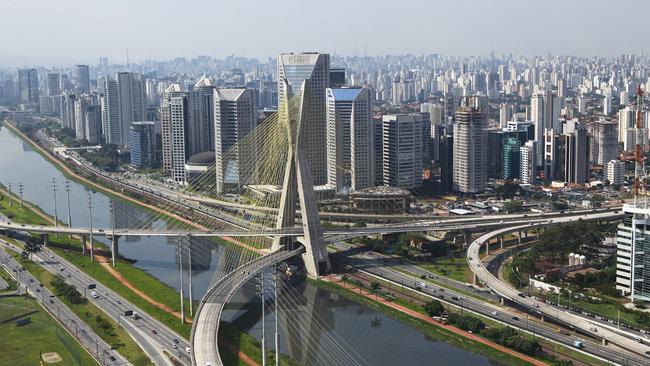The wealthy megacity on the brink of disaster
IT’S a city of more than 11 million people in a wealthy region. But this megacity is facing a huge problem, and time is running out.

IT’S a city that more than 11 million people call home, and it’s located in one of the wealthiest regions of South America.
Yet Brazil’s bustling Sao Paulo is a megacity on the brink of disaster. There’s water everywhere, but barely a drop to drink. Despite the country having the largest supply of freshwater in the entire world, it has been battling a huge water problem for months. And now, the state government is so desperate to save the city that it has come up with a controversial “solution”. It wants to tap into a long-polluted dam in an area locals described to the Wall Street Journal as “a foul soup of raw sewage laced with human excrement”. While the government says it will use treated water only from the non-polluted parts of the Billings reservoir, scientists have warned it would be a dangerous move due to the high levels of faecal matter and contaminants. It hasn’t been used as a potable water source for decades, and locals won’t even swim in it. “If they want to use this water, they will have to stop this [pollution] first,” marina worker Valdir Mastrocezari, 56, who blames contaminants for a rash on his arms, told the WSJ. “People don’t swim here. We avoid putting our feet in the water.” The plan is one of several proposals put forward in a bid to end the water crisis which has left millions going without it for days on end. So what’s to blame for the region’s worst drought in 80 years? Brazil has more freshwater than any other country on the planet — with 12 per cent of the entire world’s volume, the global research organisation World Resources Institute reports. But a change in weather patterns has hit hard. According to the WRI: “The ongoing drought in Southeastern Brazil offers a prime example of how damaging a major supply drop can be over the course of a year. (It began) between December 2013 and February 2014, historically the wettest time of year. “The region received only half its usual amount of rain, according to NASA’s Earth Observatory.” And it’s not the only factor — environmental destruction is also to blame. “Expert consensus is building around deforestation as a major driver of this year’s drought and other serious dry periods in Brazil. In 2009, Antonio Nobre, a scientist at Brazil’s Center for Earth Systems Science warned that Amazonian deforestation could interfere with the forest’s function as a giant water pump; it lifts vast amounts of moisture up into the air, which then circulate west and south, falling as rain to irrigate Brazil’s central and southern regions. “Without these ‘flying rivers’, Nobre said, the area accounting for 70 per cent of South America’s (gross national product) could effectively become desert.” Authorities already have imposed water-saving measures in Sao Paulo, including cut rates for people who limit usage, reduced pressure in water lines during off-peak hours and de facto rationing: some areas receive water only half the day. And it looks set to continue — the crucial Cantareira water system, which provides water to about 6 million of the 20 million in the metropolitan area of Sao Paulo state, is still only about one-fifth full. Environment Minister Izabella Teixeira said those programs must be expanded, and the government is preparing “a rational water-use program”. But some think that may not be enough. Many also question the amount of water that’s going to waste in the system — with an estimated 30-35 per cent of its water supply lost due to leakage. Earlier this year the president of Brazil’s Water Regulatory Agency, Vicente Andreu, warned Sao Paulo residents of a “collapse like we’ve never seen before” if drought conditions persisted. — With wires




